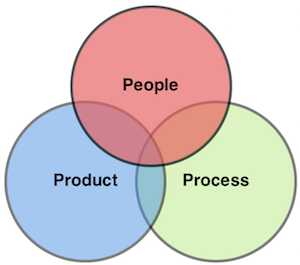The Triple P

Those wondering about moving from technical leadership to engineering management always ask me the same questions: What am I going to do? What is expected from me? How are you going to performance-manage me?
Answering all of them is definitely more than one article but I always use the same über simple framework to describe their new duties during a career development discussion.
I call it the Triple P: Product, People, Process.
Product
What’s the output of the people you’ll manage?
Technology? Infrastructure? Product Features? You’ll be accountable for what your team delivers, its product.
Managers are judged on the throughput of their team. Add another dimension, like high quality, speed or cost, and you have exactly what I’ll be “performance managing” you against.
Ultimately, nothing else matters.
In order to do this, you have two resources at your disposal: People and the system they’re part of, the Process & Organization.
People
This is a wide subject, and I’ll dig deeper in later blog posts, but as a manager, you have 3 type of relationships that you have to leverage to move your product forward: up, down and lateral.
Down, it’s me 1.
I expect you to keep me updated of everything that is happening in your team.
What do you need? Who performs well? Who doesn’t? When should I drop in one of your team meetings to help? What are the blockers to you shipping product? Do you foresee risks? What should be improved that is out of your control?
Up, it’s your reports 2.
Your duty is to support and protect them. It’s your duty to retain and grow them. If half your team leaves, it might be because of you. People leave bad managers. Don’t be one. Don’t forget: you can not ship without people. Hire them. Help them get better. Help them figure out what’s next for them in the company. Help them understand the path in their career.
Your role is also to guide them and keep them aligned. What should they do? Why? How should they do it? Set the right goals and expectations for them.
Lateral, it’s your peers.
It’s your job to create the bridges and reach out to the people that can help you. Never believe they’ll do it for you. If you need help bridging these gaps, tell me.
Think about who can help your team? Who needs a nudge? Which team’s roadmap is blocking yours?
In an ideal world, the right people would get things done by themselves, but most of the time, there is a need for processes to support them, because you want them to work together, and not along each other.
Process & Organization
Finally, the last P. Process! As with People, it’s a vast subject. I blogged about it in the past, and will continue in the future.
At its core, process is a tool to support your people in delivering the product your are responsible for.
You are not only accountable for mainting the process. In reality you are responsible for finding the right process and continuously improve it.
How should the people you manage work with each other? How should they communicate? How should they interact with other teams? What are the common set of rules and practices you want them to follow in order to deliver?
Takeways
In a nutshell, as an engineering manager, you’ll be expect you to:
- Get your team to deliver
- Hire, grow and retain talent
- Build and continuously improve how your teams gets stuff done